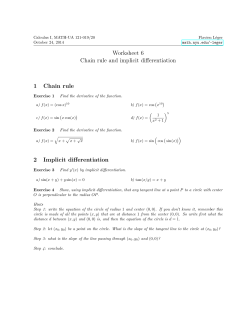
Answers for Problems Assigned Week 4
EC630 Mathematical Economics Answers for Problems Assigned Week 4 R Congleton B. Use the implicit function theorem on your answers to part A to: i. Write the ideal levels of output as a function of parameters of each firm's choice problem. [ALREADY DONE ABOVE.] I. Problem Set (Collected next week) ii. Find the derivatives of profit maximizing output levels with respect to wage cost, w. A. Characterize a firm's profit maximizing level of output, Q, for the following firms. Each firm produces its output at cost C and sells its output at price P: a. i. C = w(Q 2 + 1) where P = Po (w is the wage rate) The derivative with respect to w for i can be determined directly without using the implicit function differentiation rule. a. Π = PQ - C = PoQ - w(Q2 + 1) Q* = Po /2w = Po (2w)-1 b. Differentiating with respect to Q yields: which implys that o P - 2wQ = 0 Q*w = Po (-1) (2w)-2 ( 2 ) = - Po / 2w2 < 0 at Q* so Q* = Po /2w [ Note that this result appears to differ from what one gets applying the implicit function differentiation rule: ii. C = c(Q, w, r) where P = Po (r is the rental cost of capital, cost function c is monotone increasing and strictly convex, e.g. has positive second derivatives.) a. Π = PQ - C = P Q - c(Q, w, r) b. Differentiating with respect to Q yields: given H = Po - 2wQ = 0 at Q*, and Q*w = Hw/- HQ the implicit function differentiation method implies that o Q*w = -2Q/-(-2w) = Q*/-w . However, recall that Q* = Po /2w so Q*/-w = - Po /2w2 ! ] Po - CQ = 0 at Q* b. or applying the implicit function theorem Q* = q ( Po, w, r) iii. C = c(Q,w, r) and P = p(Q,Y) ( The cost function, c, is as before, and inverse demand function p is decreasing in Q and increasing in Y.) a. Π = PQ - C = p(Q,Y)Q - c(Q, w, r) b. Differentiating with respect to Q yields: PQQ + P - CQ = 0 For ii, let H = Po - CQ = 0 at Q* , the implicit function differentiation rule implies that: Q*w = Hw/- HQ = (-CQW)/-(-CQQ) = - CQW/CQQ < 0 if CQW > 0 and CQQ > 0 [ This implies that if marginal cost increases with output at an increasing at Q* rate ( which is the case if production exhibits diminishing marginal or applying the implicit function theorem returns at Q*), an increase in wages causes output to fall. ] Q* = q(Y, w, r) answers page 1 EC630 c. Mathematical Economics For iii, let H = PQQ + P - CQ = 0 at Q* Q*w = Hw/- HQ = (-CQW)/-(PQQQ + 2PQ - CQQ) = CQW/(PQQQ + 2PQ - CQQ) < 0 if CQW > 0 and ΠQQ < 0 [ This result implies that monopoly output falls as wages increase if the profit function is strictly concave, ΠQQ < 0, and wage increases cause marginal cost to rise, CQW > 0.] iii. What, if anything, do your answers to part Bii imply about the short run effect of new labor laws that increase wage rates in the industry of interest? a. Both competitive firms and monopolistic firms reduce their output as wages increase. Thus, one would expect new labor laws that increase real wages to cause a reduction in real industrial output. For example, mandating the purchase of healthcare can be thought of as an exogenous increase in wages (e. g. the cost of labor rises). The above results suggest that output in affected industries will decline--regardless of whether markets are monopolistic or competitive. b. Of course this is a partial equilibrium result. If labor markets eventually clear, the the total wage package will adjust to equate the labor supply with demand. In this case, money wages will fall by about the same amount as the extra health coverage cost per employee increases. (That is to say, in equilibrium, approximately the same total real wage will clear the market as in the original preregulation case.) answers page 2 R Congleton
© Copyright 2025











